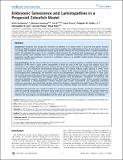Embryonic Senescence and Laminopathies in a Progeroid Zebrafish Model
Author(s)
Koshimizu, Eriko; Imamura, Shintaro; Qi, Jie; Toure, Jamal; Valdez Jr., Delgado M.; Carr, Christopher E.; Hanai, Jun-ichi; Kishi, Shuji; ... Show more Show less
DownloadKoshimizu-2011-Embryonic Senescence.pdf (1.659Mb)
PUBLISHER_CC
Publisher with Creative Commons License
Creative Commons Attribution
Terms of use
Metadata
Show full item recordAbstract
Background: Mutations that disrupt the conversion of prelamin A to mature lamin A cause the rare genetic disorder Hutchinson-Gilford progeria syndrome and a group of laminopathies. Our understanding of how A-type lamins function in vivo during early vertebrate development through aging remains limited, and would benefit from a suitable experimental model. The zebrafish has proven to be a tractable model organism for studying both development and aging at the molecular genetic level. Zebrafish show an array of senescence symptoms resembling those in humans, which can be targeted to specific aging pathways conserved in vertebrates. However, no zebrafish models bearing human premature senescence currently exist. Principal Findings: We describe the induction of embryonic senescence and laminopathies in zebrafish harboring disturbed expressions of the lamin A gene (LMNA). Impairments in these fish arise in the skin, muscle and adipose tissue, and sometimes in the cartilage. Reduced function of lamin A/C by translational blocking of the LMNA gene induced apoptosis, cell-cycle arrest, and craniofacial abnormalities/cartilage defects. By contrast, induced cryptic splicing of LMNA, which generates the deletion of 8 amino acid residues lamin A (zlamin A-Δ8), showed embryonic senescence and S-phase accumulation/arrest. Interestingly, the abnormal muscle and lipodystrophic phenotypes were common in both cases. Hence, both decrease-of-function of lamin A/C and gain-of-function of aberrant lamin A protein induced laminopathies that are associated with mesenchymal cell lineages during zebrafish early development. Visualization of individual cells expressing zebrafish progerin (zProgerin/zlamin A-Δ37) fused to green fluorescent protein further revealed misshapen nuclear membrane. A farnesyltransferase inhibitor reduced these nuclear abnormalities and significantly prevented embryonic senescence and muscle fiber damage induced by zProgerin. Importantly, the adult Progerin fish survived and remained fertile with relatively mild phenotypes only, but had shortened lifespan with obvious distortion of body shape. Conclusion: We generated new zebrafish models for a human premature aging disorder, and further demonstrated the utility for studying laminopathies. Premature aging could also be modeled in zebrafish embryos. This genetic model may thus provide a new platform for future drug screening as well as genetic analyses aimed at identifying modifier genes that influence not only progeria and laminopathies but also other age-associated human diseases common in vertebrates.
Date issued
2010-03Department
Massachusetts Institute of Technology. Department of Earth, Atmospheric, and Planetary SciencesJournal
PLoS ONE
Publisher
Public Library of Science
Citation
Koshimizu, Eriko et al. “Embryonic Senescence and Laminopathies in a Progeroid Zebrafish Model.” Ed. Alfred Lewin. PLoS ONE 6.3 (2011) : e17688.
Version: Final published version
ISSN
1932-6203